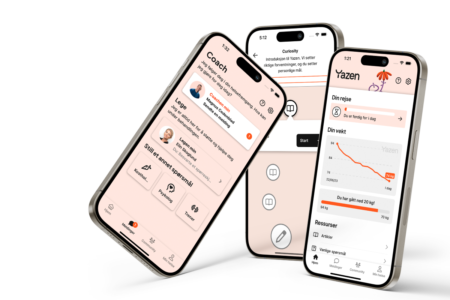In recent years there has been an increase in the offer of glasses with yellow or red lensesas well as that of red or yellow light devices that promise to protect the eyes, improve sleep and even "reset" the brain. The internet is full of testimonials and online shops are full of futuristic-looking models, but what is really behind this trend? But what is really behind this trend, are they useful or pure marketing, and which lights, screens or bulbs are really dangerous for our eyes or brain balance?
Our visual environment has changed dramatically. Constant exposure to cool white LED lightsmobile phone screens, computer screens and artificial light sources rich in blue wavelengths (400-480 nm) has attracted scientific interest because of its effects on the retina and the circadian system.
During the day, this blue light stimulates attention and alertness. But at night, the same radiation can inhibit melatonin secretion y altering biological rhythmsThis makes it difficult to sleep and affects emotional balance. Exposure to cold screens or lights at night is, in fact, one of the most recognised factors in modern sleep disorders.
Yellow by day, red by night: how and when to wear them
This is the first major difference that is often overlooked by consumers:
- Yellow or amber lensesare recommended for daytime or indoor use. They filter out part of the scattered blue light (415-455 nm), soften the excessive contrast of LED lights and reduce glare in offices or gymnasiums with cold white lighting. They allow high light transmission (VLT >70%) and do not drastically distort colours.
- Red lenses: they are used at nightespecially when seeking to avoid circadian stimulation. These lenses block practically the entire blue and green band, letting only red light (>600 nm) through. They promote relaxation and melatonin production, which is why some experts recommend them before bedtime or for night-time tasks in low light.
That's right: not just any coloured plastic will do. What determines the effectiveness of a pair of spectacles is not the visual colour, but rather their spectral transmittance curvei.e. what percentage of light it lets through at each wavelength.
What materials should they have (and why does it matter)?
Quality lenses are made of certified optical materials - not uncontrolled tinted plastic. The most common are:
- PolycarbonateImpact resistant, lightweight and with integrated UV protection.
- CR-39 (organic resin)excellent optical quality, but needs additional UV treatment.
- Trivex or high index materialsLighter and stronger, ideal for extended wear glasses.
Dyes and coatings determine the filtering range. Some manufacturers integrate reflective coatings that return some of the blue light without obscuring vision. Others incorporate absorbent dyes which selectively dissipate blue-violet energy.
The important thing is that the product is accompanied by a spectral transmittance report (380-780 nm). If on the graph you see that the transmission drops sharply between 415 and 455 nmThe lens effectively blocks high-energy blue light. If the graphic does not exist, the filter is probably cosmetic.

How to know if a pair of glasses is approved
To distinguish a real wellness tool from a simple aesthetic accessory, always ask for these details or markings:
- Spectral transmittance curve: document showing absorption by wavelengths.
- % locking at 415-455 nm y VLT (Visible Light Transmission)for daytime use, VLT >70%; for night-time use, total blocking below 600 nm.
- Standard markingin Europe, look for EN ISO 16321 o EN 166in the USA, ANSI Z80.3 (sunglasses) or Z87.1 (eye protection).
- Eyesafe® or RPF (Radiance Protection Factor) Certificationsectoral standards that define what level of blue screening the product offers.
- UV400 protection y endurance tests (impact, scratches, dye stability).
Without this data, you are looking at a decorative accessory, not an approved optical filter.
Red and yellow light as therapy: the rise of photobiomodulation
There is no need to confuse the tinted glasses with the devices emitting red or yellow light. The latter belong to the field of photobiomodulation (PBM)a technique that uses wavelengths between 600 and 900 nm to stimulate cellular processes.
Recent clinical studies have shown that controlled exposure to red light can temporarily improving visual function in cases of macular degenerationto promote the mitochondrial recovery y reduce markers of oxidative stress. Some systems, such as the Valedahave received FDA approval for specific medical use in ophthalmology.
However, the success of this therapy is dependent on precise parameters (wavelength, power, time, distance, frequency) and a controlled environment. A home lamp with red LEDs does not guarantee these results, nor should it replace medical treatments.
The yellow light(≈580-600 nm), meanwhile, is investigated for its ability to reduce skin inflammation y promote collagen productionbut its ocular benefits are much less conclusive.
Which lights and displays are really dangerous
- Circadian and sleep risk: blue-rich light (screens, cool LEDs, fluorescent tubes) at night is the main sleep disruptor. It does not cause retinal damage, but it does disrupt the biological clock.
- Risk of direct eye damage: Only intense sunlight, lasers or high-energy industrial sources can cause physical damage to the retina. Household lampshades and bulbs do not reach harmful levels.
- Risk of eyestrain: is more a result of exposure time, dry eyes or poor ergonomics than of the type of light.

The business behind the colour
The global market for anti blue light" glasses y therapeutic light devices is growing at double-digit annual growth rates. The most recent forecasts put their combined value at more than one billion dollars by 2030. Wellness fads and hybrid work have created consumers looking for drug-free "biohacking" solutions. But among the real innovations are many products that do not meet even a basic standard of filtering.
Some brands have started to publish their transmittance curves and certificationswhich is a good sign. Others simply add a blue tint or coating without spectral control and sell it as "advanced eye protection". The difference is not visible to the naked eye, but is measured in the laboratory.
What the science says (and what it doesn't)
The most recent systematic reviews agree:
- The blue light filtering glasses offer little or no measurable clinical benefit on eye fatigue or sleep quality in the general population.
- The benefits reported by users are subjective or are due to behavioural changes (reducing brightness, taking breaks, avoiding screens before bedtime).
- The photobiomodulationon the other hand, it does show measurable effects in specific pathologies (such as macular degeneration), although it requires validated clinical protocols.
- In everyday life, the best strategy is still the visual hygieneThe following are the main factors to be taken into account: regular breaks, good ambient lighting, moderate use of screens and eye rest.
Practical guide
- By day, indoors with cool LED light: goggles yellow or amber with high transmission (VLT >70%) and certified filtering at 415-455 nm.
- At night: goggles reds blocking below 600 nm, or simply reduce exposure to screens and opt for warm bulbs or dim light.
- For sleep: avoid cool white light 1-2 hours before bedtime; use amber or dim red lighting.
- For eye health or aesthetics: if you use red light o photobiomodulationconsult medical sources and avoid imitations without validated parameters.
- When buying: always requires a transmittance curve, CE or ANSI marking and UV protection certificate.
The yellow lenses y reds are not just a fashion accessory, but not a miracle solution either. Properly used, they can improve visual comfort and support circadian hygiene; poorly chosen, they are just coloured plastic.
And while science continues to fine-tune the parameters of the photobiomodulationThe real revolution in visual comfort is less about the colour of the glass and more about the basics: regulating the light that surrounds us and respecting our body's rhythms.






